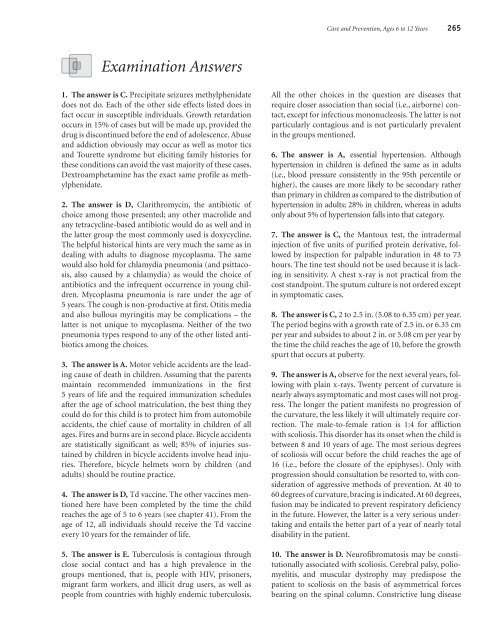NMS Q&A Family Medicine
NMS Q&A Family Medicine
NMS Q&A Family Medicine
- No tags were found...
You also want an ePaper? Increase the reach of your titles
YUMPU automatically turns print PDFs into web optimized ePapers that Google loves.
Care and Prevention, Ages 6 to 12 Years 265Examination Answers1. The answer is C. Precipitate seizures methylphenidatedoes not do. Each of the other side effects listed does infact occur in susceptible individuals. Growth retardationoccurs in 15% of cases but will be made up, provided thedrug is discontinued before the end of adolescence. Abuseand addiction obviously may occur as well as motor ticsand Tourette syndrome but eliciting family histories forthese conditions can avoid the vast majority of these cases.Dextroamphetamine has the exact same profile as methylphenidate.2. The answer is D , Clarithromycin, the antibiotic ofchoice among those presented; any other macrolide andany tetracycline-based antibiotic would do as well and inthe latter group the most commonly used is doxycycline.The helpful historical hints are very much the same as indealing with adults to diagnose mycoplasma. The samewould also hold for chlamydia pneumonia (and psittacosis,also caused by a chlamydia) as would the choice ofantibiotics and the infrequent occurrence in young children.Mycoplasma pneumonia is rare under the age of5 years. The cough is non-productive at first. Otitis mediaand also bullous myringitis may be complications – thelatter is not unique to mycoplasma. Neither of the twopneumonia types respond to any of the other listed antibioticsamong the choices.3. The answer is A. Motor vehicle accidents are the leadingcause of death in children. Assuming that the parentsmaintain recommended immunizations in the first5 years of life and the required immunization schedulesafter the age of school matriculation, the best thing theycould do for this child is to protect him from automobileaccidents, the chief cause of mortality in children of allages. Fires and burns are in second place. Bicycle accidentsare statistically significant as well; 85% of injuries sustainedby children in bicycle accidents involve head injuries.Therefore, bicycle helmets worn by children (andadults) should be routine practice.4. The answer is D, Td vaccine. The other vaccines mentionedhere have been completed by the time the childreaches the age of 5 to 6 years (see chapter 41). From theage of 12, all individuals should receive the Td vaccineevery 10 years for the remainder of life.5. The answer is E. Tuberculosis is contagious throughclose social contact and has a high prevalence in thegroups mentioned, that is, people with HIV, prisoners,migrant farm workers, and illicit drug users, as well aspeople from countries with highly endemic tuberculosis.All the other choices in the question are diseases thatrequire closer association than social (i.e., airborne) contact,except for infectious mononucleosis. The latter is notparticularly contagious and is not particularly prevalentin the groups mentioned.6. The answer is A, essential hypertension. Althoughhypertension in children is defined the same as in adults(i.e., blood pressure consistently in the 95th percentile orhigher), the causes are more likely to be secondary ratherthan primary in children as compared to the distribution ofhypertension in adults; 28% in children, whereas in adultsonly about 5% of hypertension falls into that category.7. The answer is C, the Mantoux test, the intradermalinjection of five units of purified protein derivative, followedby inspection for palpable induration in 48 to 73hours. The tine test should not be used because it is lackingin sensitivity. A chest x-ray is not practical from thecost standpoint. The sputum culture is not ordered exceptin symptomatic cases.8 . The answer is C, 2 to 2.5 in. (5.08 to 6.35 cm) per year.The period begins with a growth rate of 2.5 in. or 6.35 cmper year and subsides to about 2 in. or 5.08 cm per year bythe time the child reaches the age of 10, before the growthspurt that occurs at puberty.9. The answer is A, observe for the next several years, followingwith plain x-rays. Twenty percent of curvature isnearly always asymptomatic and most cases will not progress.The longer the patient manifests no progression ofthe curvature, the less likely it will ultimately require correction.The male-to-female ration is 1:4 for afflictionwith scoliosis. This disorder has its onset when the child isbetween 8 and 10 years of age. The most serious degreesof scoliosis will occur before the child reaches the age of16 (i.e., before the closure of the epiphyses). Only withprogression should consultation be resorted to, with considerationof aggressive methods of prevention. At 40 to60 degrees of curvature, bracing is indicated. At 60 degrees,fusion may be indicated to prevent respiratory deficiencyin the future. However, the latter is a very serious undertakingand entails the better part of a year of nearly totaldisability in the patient.10. The answer is D. Neurofibromatosis may be constitutionallyassociated with scoliosis. Cerebral palsy, poliomyelitis,and muscular dystrophy may predispose thepatient to scoliosis on the basis of asymmetrical forcesbearing on the spinal column. Constrictive lung disease
















